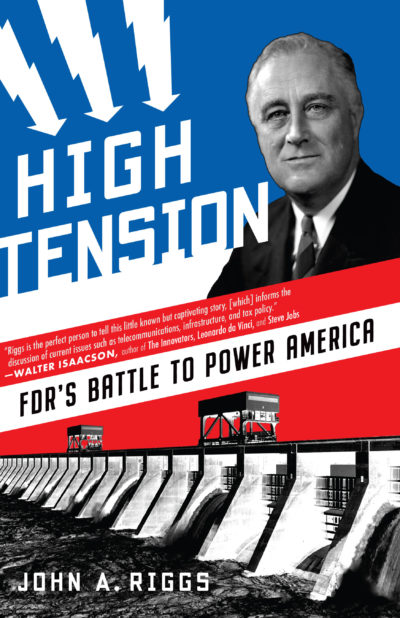High Tension: FDR’s Battle to Power America
- By John A. Riggs
- Diversion Books
- 320 pp.
- Reviewed by David O. Stewart
- December 3, 2020
The electrifying tale of Roosevelt’s effort to light the land.

When I volunteered to review this book, an editor of this distinguished publication congratulated me on selecting the most boring-sounding book that the Independent will ever cover. My reaction to this unprovoked calumny? To quote our soon-to-depart Maximum Leader: Sad.
We all depend on electric power. Even that benighted editorial remark was dispatched as electric impulses. No power, no Zoom! The destruction of our climate and planet is in significant part being achieved by the mad construction of coal-fired power plants across the globe. Shouldn’t we understand, even in a small way, this essential industry?
John A. Riggs, the author of High Tension, is a power-industry expert reaching out to those of us who are not. He works to draw us into the story of how America’s power industry developed in the 1930s into its current mix of private, regulated utilities and publicly owned enterprises — something he charitably labels a “distinctive hybrid system.”
The book features winning vignettes. For example, ceremonies launching a new electric cooperative often included a mock funeral interring a kerosene lamp. A Pennsylvania utility lobbied a congressman with 800 telegrams, almost all of which were signed by constituents whose last names began with the first few letters of the alphabet. Investigation revealed that the names came from the phone book (ask your parents) and the constituents had no connection to the telegrams.
Riggs salts his narrative with pithy observations from Will Rogers, who looked askance at the utility companies’ crusade against public ownership of power production. “They all say the government can’t do anything toward running any business but they break their necks to see that it don’t try.”
(Could this observation apply, in our day, to the “public option” for health insurance and Obamacare? I digress.)
The meat of the saga, however, is the decades-long struggle to end the financial legerdemain that infested the electricity business, which constructed pyramid schemes with up to 10 levels of holding companies owning holding companies, all designed to divert profits to top financiers while placing the least amount of capital at risk.
As one executive wrote, the goal was to “scrambl[e] all these reorganizations together so that about the only thing the Pennsylvania Commission will be able to understand will be the result and not how the result was reached.” Such shenanigans, unavoidably, can be heavy narrative sledding.
At the same time, utilities built local and regional monopolies that allowed them to charge excessive rates while not providing service to rural communities, which involved greater investment with less payoff.
Enter Franklin Roosevelt. First as New York’s governor, then as president, FDR applied his subtle political wizardry to reform the industry in the public interest. A key tool was hydroelectric power produced by dams on major rivers like the Niagara, the Tennessee, the Columbia, and the Colorado.
Because local and state governments clamored for flood control and irrigation as well as power, FDR kept the private utilities largely out of the hydroelectric business, which paid for giant structures like the Grand Coulee and Hoover dams.
By having public bodies control the power produced by the dams, Roosevelt and his men brought down electricity prices. With tougher regulation and by subsidizing the delivery of electricity to rural cooperatives, FDR’s New Deal gave farm families light at night, water pumps and heaters, washing machines, radios, and refrigerators. Imagine the things you could not do, and the chores you would have to do, without electric power. As one co-op employee remembered, “When the first switch was turned on, they literally cried and shouted with joy.”
It wasn’t easy. Riggs highlights the confrontation between Roosevelt’s reformers and utility kingpin Wendell Willkie. Though Willkie became an effective Republican candidate for president in 1940, and later a partner in FDR’s efforts to win World War II, his prewar arrogance was breathtaking. As recalled by the chairman of one agency:
“He would walk across the room, pull up a chair, sit down with his back to me, put his feet on the window sill and bellow at me. What interested me most was that he kept his hat on — better to show his contempt.”
Presenting a story that mingles business and politics at the highest level, High Tension has a complex tale to tell, one that requires the reader’s attention. But boring? Nope.
David O. Stewart writes history and historical fiction. In February, Dutton Books will release his George Washington: The Political Rise of America’s Founding Father.
_80_122.png)
